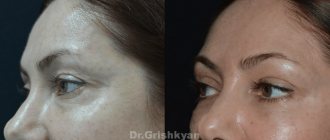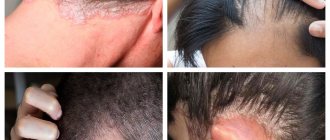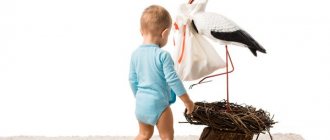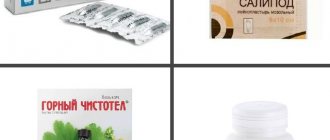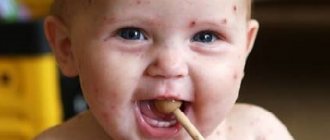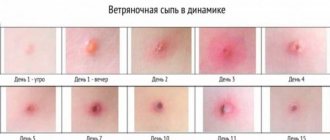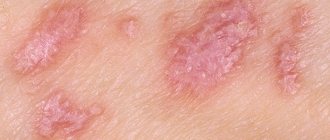Reasons for the formation of warts in children
The following infection mechanisms can provoke the appearance of warts in a child on the hands, face or body:
- Personal contact with a person who is a carrier of the HPV virus;
- Infection through household items (for children this can be shared toys);
- Plantar warts in children may appear as a result of visiting a public swimming pool or gym.
However, even with direct penetration of the papilloma virus into the child’s body, the formation of unpleasant neoplasms does not necessarily occur. A wart on a child’s finger or face can only appear if several accompanying factors are combined:
- Severe decrease in immunity, including due to hypovitaminosis;
- The presence of injured areas of the skin: scratches, abrasions, wounds, microcracks;
- Excessive sweating of the feet can lead to the appearance of a wart on a child's foot;
- Wearing uncomfortable, too narrow shoes.
When should you see a doctor?
The main symptom is pain in the foot after static exercise or long walking.
It may be accompanied by discomfort in the calf muscles. In severe cases, the pain becomes constant. It is worth seeking a consultation if you notice the following symptoms:
- enlargement of the “bone”,
- soreness and redness;
- deformation of toes;
- pain in the joints of the foot;
- feeling tired after light exertion;
- difficulties with choosing shoes.
How is hallux valgus diagnosed?
Our leading orthopedic traumatologist Anton Andreevich Akulaev can already at the first appointment identify a set of typical disorders, make a clinical diagnosis and prescribe additional examinations to confirm it. Additional methods that allow differential diagnosis and clarification of the diagnosis:
- plantography;
- radiography;
- podometry.
Is it possible to cure this pathology?
Yes, you can. It all depends on the severity of the disease. At the initial stages of deformation, treatment must begin with conservative methods.
Conservative therapy includes:
- wearing comfortable shoes,
- orthopedic insoles,
- use of corrective bandages on the thumb,
- physiotherapy,
- massage.
Surgical intervention is necessary if conservative measures are ineffective, and severe pain is present. The goal of the surgery is to eliminate pain and create a functional foot. “Beautiful legs” become just a pleasant addition. The issue of surgical treatment should be decided only if all conservative measures taken are ineffective, especially when it comes to elderly patients.
Surgical treatment of hallux valgus deformity
Recommended if conservative measures are ineffective and there is severe pain. The presence of only a cosmetic defect is not an indication for surgery. The goal of the surgery is to eliminate pain and create a functional foot. “Beautiful legs” become just a pleasant addition. Treatment of hallux valgus (valgus deformity of the first toe, “bone” on the foot). With minor deformation, movement in the metatarsophalangeal joint is full and painless. At this stage of the disease, improvement is facilitated by changing shoes to more comfortable ones and using orthopedic insoles. Surgical treatment is indicated only in the presence of pain.
Simple removal of the “bone” during surgical treatment is usually not sufficient. It is necessary to perform a corrective osteotomy of the metatarsal bone in cases of moderate and severe deformity.
Correction of the deformity is carried out by resection of the protruding bone tissue, as well as correction of the angle between the metatarsal bones by positioning the first metatarsal bone. The result of the operation is to restore the function of the joint. For the treatment of the “bone” of the foot in the Clinic of High Medical Technologies named after. N.I. Pirogov uses a low-traumatic method. Surgical manipulation mainly affects soft tissue and is performed on tendons. This shortens the recovery period after surgery. For surgical correction, two incisions are sufficient: one on the inner surface of the foot, and the other in the space between the toes. For pain relief, anesthesia is used, the type of which is determined by the anesthesiologist, taking into account the general condition of the patient and concomitant diseases.
Preparing for surgery
The patient undergoes general training: consultation with various specialists, rehabilitation and elimination of possible contraindications.
Contraindications to surgery are:
- inflammatory and infectious processes of the skin and soft tissues of the foot;
- pathology of the vascular system of the lower extremities;
- disorders of the blood clotting system;
- decompensation of body systems and severe impairment of their functions.
The doctor monitors general tests and vital signs, which determine the patient's readiness for surgical treatment. After the operation, the patient is given a tight elastic bandage that limits movement. A rehabilitation program is gradually developed, during which the range of motion is restored and the patient returns to normal activity. The attending physician recommends during what period you can put weight on your leg again. It is also recommended to wear special shoes and arch supports.
Types of warts in children and teenagers
Before choosing a treatment method for childhood tumors, you should determine the type of wart, which can often be done based on the appearance of the skin growth and its location:
- Common warts. The most common type, which most often appears as warts on the fingers of children, and can also be localized in the knee and elbow areas. These formations have a rough surface and usually differ slightly in color from healthy epidermis, having a dark, grayish tint.
- Flat warts. They have a smooth, even surface, although the color can be either yellowish or pinkish. Such neoplasms are characteristic not only of children, but are also often diagnosed in adolescents during puberty. Since such defects are most often localized in the area of the nasolabial triangle, chin and mouth, treatment of flat warts on a child’s face is a common practice that requires an exclusively professional approach to avoid the formation of scars, scars and burns.
- Plantar warts in children. A wart on a child's foot is usually accompanied by hyperkeratosis - thickening of the skin. The color of such a neoplasm can range from light beige to dark gray. The child complains of discomfort when walking, which is manifested by the feeling of a pebble in the shoe.
- Filiform warts. The rarest type of neoplasm caused by the papilloma virus, which most often appears in the mouth, eyes, nose, and can also form directly on the mucous membrane of the organ.
Why do warts appear?
The formation is caused by the human papillomavirus (HPV) of various types (currently there are more than 100 varieties). Infection occurs through contact (from person to person) and household contact (through common objects, contaminated surfaces - swimming pools, saunas, gyms). Cases of self-infection are common.
The virus that enters the body through microtrauma actively multiplies in the surface layers of the skin. The latent period lasts 1-6 months, then typical nodules appear.
In practice, most often we encounter flat and vulgar warts. Vulgar ones are predominantly located on the dorsum of the hands. These are multiple painless dense rounded gray papules with an uneven, keratinized surface of a flesh-colored or yellow-brown color. Flat warts are located on the back of the hands, forearms, as well as the face and mucous membranes. Clinically, they are represented by small multiple papules the color of normal skin. On the surface of both, black dots can be seen - these are thrombosed capillaries.
Where to go if a child has warts?
If parents notice any skin growths or neoplasms in their child, it is recommended to consult an experienced doctor as soon as possible, who will determine an accurate diagnosis and recommend effective treatment methods . Warts can sometimes be confused with nevi or manifestations of lichen planus. In this regard, independent treatment, especially in relation to a child, is unacceptable. The specialist will not only tell you how to treat warts in children, but will also give advice on the need for therapy. The fact is that some types of neoplasms can spontaneously disappear as the child grows. If the formation is located on the face and causes significant aesthetic discomfort to the patient, there is no need to delay solving this problem.
How to tell if your child has a plantar wart
Externally, these formations, which are popularly called “spikes,” resemble small growths on the feet. It is quite easy to recognize rough and dead skin, around which a kind of ring is formed. In its center you can see miniature black dots - clogged blood vessels, and on the outside - grooves and papillae. If you find something like this on your son or daughter's foot, it's time to consult a dermatologist before the growths grow and turn a dirty gray color.
Plantar warts cause a lot of inconvenience for a child. They itch and interfere with wearing shoes, and also cause not just unpleasant, but painful sensations. Sometimes the formations disappear on their own, but not earlier than after one and a half to two years: all this time, the teenager or child will have to put up with discomfort, unless the parents quickly solve the problem by contacting a dermatologist.
After operation
Dosed loads on the leg are possible from the next day after surgery. Despite this, in the first two weeks of the postoperative period it is recommended to use additional support for movement (cane) for better and faster healing of the postoperative wound. Complete restoration of the supporting function of the lower limb occurs by 4-6 weeks after surgery.
Recommendations for the prevention of Hallux Valgus from our doctors
There are certain preventive measures that can be taken to avoid or stop the progression of a “bump on the foot.”
- 1. Eat right.
Eliminate spicy and salty foods from the menu, limit your intake of carbohydrates and sugar. Add vegetables and fruits to your diet. Watch your weight, because as we wrote earlier, extra pounds increase the load on the feet and provoke deformation. - 2. Do exercises for your feet.
Spend 5-10 minutes doing simple exercises. The main condition for gymnastics is its regularity. Daily exercise strengthens the muscles and ligaments of the foot:
- — scatter small objects on the floor and collect them with your fingers (pens, pencils, eraser, sheet of paper);
- - walk on your toes and heels;
- — draw with your fingers in the air or on the sand (floor) whatever your heart desires;
- - spread your fingers so that they do not touch. Hold in this position for at least a minute;
- - Roll a water bottle with your foot.
- 3. Foot massage.
You can do foot massage yourself at home. Follow the basic rules:
- — Hands should be warm and dry.
- — Massage 2 times a day: morning and evening.
- - Rub your feet and toes. Use tapping and stroking movements, focusing on the inner surface of the sole.
- — Fingers should be massaged from the tips towards the foot.
- - Finish the massage by bending and straightening your toes.
- 4. Foot baths.
After a hard day, warm foot baths are wonderfully relaxing and soothing. Add herbs, salt or soda. After completing the procedure, rinse your feet with cool water and gently rub the soles with a soft towel. - 5.Wear the right shoes.
Fashionistas need to minimize wearing high-heeled shoes with a narrow toe. Everyday shoes should have a stable heel - no higher than 4-5 cm, with a rounded toe, with a soft and flexible sole. - 6. Choose orthopedic insoles.
Orthopedic insoles are recommended for all people and can be worn at any age. The insoles relieve the toes, redistributing pressure along the foot. Properly selected insoles are insoles that are made using a special machine to fit your foot. - 7. Use orthoses.
Orthoses are special interdigital separator inserts that are located between the thumb and second toe. There are also different types of pads that protect the feet from corns. You can purchase them and get a consultation at any orthopedic salon in St. Petersburg. - 8. Give your legs a rest.
If work requires constant standing, it is necessary to warm up your legs at certain intervals (lower and raise your toes, “fan out” your toes, etc.).
Our Clinic provides treatment under federal quotas, which means that citizens of the Russian Federation have the opportunity to receive help free of charge. Make an appointment with an orthopedic traumatologist or on the website.
